'LA's loneliest bachelor': How a mateless Hollywood puma inspired the world's biggest animal bridge
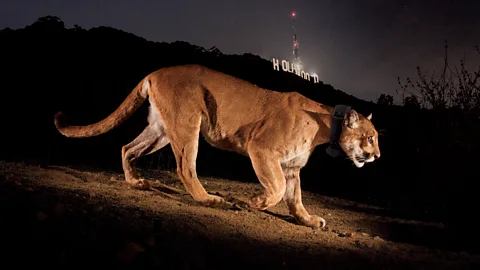 Steve Winter
Steve WinterInspired by a mountain lion isolated from potential mates, the world's largest wildlife bridge is being built in Los Angeles to allow animals to roam freely.
There had been rumours for a few months in the Hollywood Hills that a 90lb (41kg) beast was skulking through one of Los Angeles's most heavily trafficked parks at night. But it wasn't until a camera captured a photo of a mountain lion in 2012 that scientists could confirm the lore.
P-22, P as in puma (another word for mountain lion), was a 1.5-year-old male the National Park Service determined had journeyed by himself nearly 30 miles (48km), crossing two major freeways, to end up in Griffith Park, in central LA just outside of Hollywood, where he took up permanent residence.
Nearly overnight, P-22 became Los Angeles's newest celebrity – seen as a mascot for some locals. But P-22's story was also one of isolation, for the mountain lion was miles away from others of his species and would likely stay mateless for life.
When Beth Pratt, California regional executive director at the non-profit National Wildlife Federation, first read about P-22, she immediately called Jeff Sikich, a wildlife biologist for the National Park Service.
"He gave me a tour of Griffith Park. And then he talked about not just P-22 but the entire mountain lion population in the Santa Monica Mountains. And P-22 was just one example. The worst example," says Pratt.
Pratt learned from Sikich that while P-22 was rare in that he had survived leaving the western Santa Monica Mountains to cross into the eastern flank of the mountain range, he was not alone in his seclusion. Most of the mountain lions living in the western range were also stuck and inbreeding, because of how the city's transportation infrastructure had evolved.
In fact, road development in Los Angeles has cut off many species from their normal roaming territory, from bobcats to birds. Solitary mountain lions, which seek out "home ranges" of up to 250 sq miles (648 sq km), are among the most affected.
"These roads were just literally dooming this population to extinction because they were trapped and isolated and were inbreeding themselves out of existence, which science was starting to show," says Pratt. "And it was that day [at Griffith] I literally was like, 'Oh my God. We have to do something.'"
Thirteen years later, Los Angeles is gearing up to open the largest wildlife crossing in the world. Set to open in 2026, the 165ft (51m)-longbridge will mirror the desert terrain of the nearby valley and be dotted with rocks and low shrubs to reconnect the Santa Monica Mountain range. It will allow mountain lions and other species, such as coyotes, bobcats and deer, to roam more freely.
Wildlife crossings are used globally as a way to let animals safely cross roads and highways, from migrating red crabs in Australia's Christmas Island to "ecoducts" in the Netherlands used by wild boar, badgers and foxes. But Los Angeles's crossing stands out not just for its magnitude, but its location: in the US's second largest city, often considered the birthplace of the country's modern highway system.
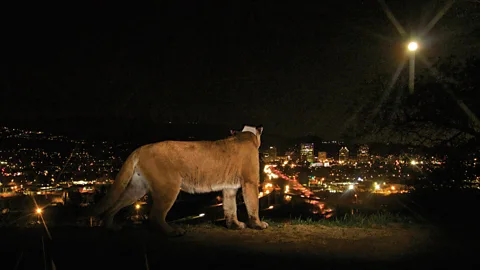 Steve Winter
Steve WinterWhat Pratt didn't know when she first learned of P-22 back in 2012 is that there was already an effort underway in Los Angeles to fix the problem of separated wildlife corridors.
Scientist and researcher Paul Edelman had for decades been putting together an effort to build a bridge between mountain ranges to let animals like pumas range more freely and lower the risk of being run over.
His efforts began in 1989 when he was a consultant for the non-profit The Nature Conservancy and was given a grant by the Santa Monica Mountains Conservancy, a state authority, to study what it would take to connect Southern California's three mountain ranges.
"I was just put in a fortunate position to where I was told, 'Okay, here's some money, and you get a year to study this and produce something.' And so I got to devote my working life to studying it and it just very soon became crystal clear what we needed to do," says Edelman, who is now deputy director of natural resources and planning at the Santa Monica Mountains Conservancy.
After he submitted the study in 1990, Edelman determined there was a need to build a crossing over the eight lanes of the 101 Freeway at a place in Calabasas called Liberty Canyon, where two parcels of publicly owned land could be connected by a bridge.
Mountain lions are routinely struck and killed by traffic in California. A 2024 report from the University of California, Davis, found that 613 of them were killed on California roads between 2016 and 2023. Vehicle collisions with large animals such as mountain lions and deer also cost $1.64bn (£1.2bn) during that seven-year period, the report noted.
The problem is especially bad near the Santa Monica Mountains, where over 300,000 cars use the 101 Freeway daily, according to Pratt. More than a third of all the mountain lion deaths on roads in California happen on the stretch of highway that crosses through these mountains, says Edelman.
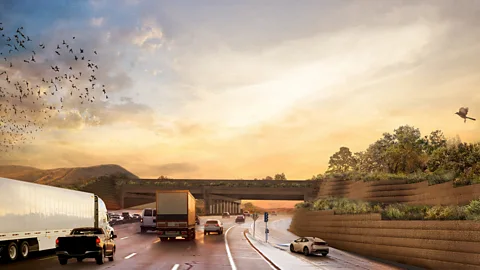 Rock Design Associates and National Wildlife Federation
Rock Design Associates and National Wildlife FederationAnimal roadkill is an issue that persists across the US but is especially a problem in the Midwest and West where there are large open roads and migrating herds of large animals from elk to deer to wolves, according to Patricia Cramer, founder of US-based non-profit The Wildlife Connectivity Institute, whose PhD was on pumas in Florida.
Cramer studies transportation ecology, which considers how animal crossings can lead to safer roads, fewer accidents, less expensive costs to automobiles and longer lives for animals. She is confident that the new crossing will benefit California's puma population. "Pumas are really widely distributed. They go 10 miles (16.1km) in a night. They will find it, and they'll find it quickly," Cramer says.
"People will say: 'All that money for one structure?' But Beth Pratt and her company, they've brought so much attention to the idea," she adds.
She says that getting communities to invest in wildlife crossings is not just about animal safety though, it also requires buy-in from local communities and state officials. "They have got to care enough to want to save the species of wildlife in their area."
In California, Edelman was so passionate about the cause he would spend the next two decades of his life working on it. To connect the two parcels of state-owned park land on either side of the 101, Edelman needed to buy up land that lined the freeway. This was largely smaller privately owned parcels of land, and he ultimately amassed 12 of these. One was a proposed storage facility, another a planned condo complex, another previously used to keep beehives, he says.
To fund these purchases, Edelman used a combination of state funds from two propositions that passed in 1992 and again in 1996, he says, which provided funds to the Santa Monica Mountains Conservancy, as well as proceeds from fees collected at a nearby county landfill. It took 32 years, but by December 2021, Edelman had purchased 439 acres (1.8 sq km) for $16m (£11.7m).
While his work was ongoing, researchers were continuing to document telltale signs of inbreeding among the species, like kinked tails and males having only one descended testicle.
"We never thought it would take that long. But the complexity of it, I guess I never gave up on it," says Edelman. "We got the land, and then somebody came through and said, 'Let's do the bridge.'"
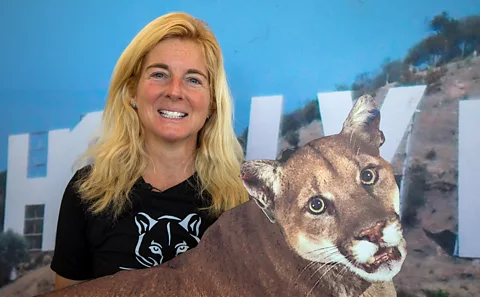 Beth Pratt
Beth PrattThe bridge would take millions more to build. That's where Pratt says she realised she could play a connecting part – as a leader at a non-profit, she could help fundraise through private donations, and she used P-22 as the face of the effort.
It started with tapping into the virality of the puma, whose famous photo in front of the Hollywood sign appeared on front pages and was featured on CBS News' 60 Minutes. The marketing campaign included a fundraising video with an actor from the US version of The Office, a "Ghost Cat" red wine that gave part of its proceed to the #SaveLACougars campaign, a P-22 ugly Christmas sweater that featured LA's notorious traffic, and a limited edition library card.
Pratt established an Instagram account for P-22 with the caption "LA's loneliest bachelor". It generated 15,400 followers. His Facebook page has 27,000 followers. The pages highlight murals dedicated to P-22 across the city, as well as progress on funding for the wildlife crossing. Pratt dubbed P-22 the "Brad Pitt" of pumas.
Pratt said some scientists thought what she was doing was bizarre – turning P-22 into a meme of sorts – but she realised the LA community connected with P-22 on a deep level.
"I think building relationships with animals is actually what we need to be doing, and what humanity has done for a long time," she says.
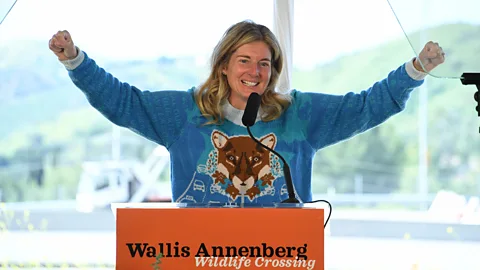 Beth Pratt
Beth PrattThe story of P-22 captivated donors. The fundraising campaign raised over $100m (£73m) for the crossing with a roughly 50/50 split between public and private funds, according to Pratt. Most of the private funds came from the Annenberg Foundation, Pratt says - leading to the crossing being named after heiress and philanthropist Wallis Annenberg.
Celebrities including Leonardo DiCaprio and Barbra Streisand donated as well as 6,000 individual contributions from people around the globe from Bolivia to Australia, Pratt adds.
To get the crossing built, the #SaveLACougars campaign turned to landscape architect Robert Rock, president of Rock Design Associates, an architecture firm based in Chicago.
Rock says he immediately connected with the project on a personal level.
"Growing up in rural Iowa, hitting a deer is a pretty common thing. It's a traumatic moment when you hit a large animal," he says.
Rock consulted with several experts including wildlife biologists and structural engineers. Their goal was to not only figure out how to build the momentous structure 210ft (64m) long and 174ft (53m) wide, says Rock,but also how to make sure animals would use it. That meant considering everything from the impact of the traffic's sound, the slope of the bridge, planted vegetation, sun glare, burying transmission lines and the colour of the poured concrete.
Fires were also a consideration, because the area frequently burns. In fact, construction was put on pause momentarily in February 2025 after a spot fire burned the freeway for a day and the Palisades fire continued to burn into Malibu nearby, according to Pratt. In 2018, the area was scorched during the Wolseley Fire, which burned 96,949 acres (392 sq km) through the Santa Monica Mountains. Plants growing on the crossing will be watered by sprinklers that can double as ground wetters in the face of future fires.
The hope is that the crossing will also be an escape route for impacted animals. During the Woolsey fire, conservationists saw the devastating impacts of isolation on mountain lions. Two tagged males perished, according to a report by Associated Press – including one that had escaped the flames but later died of malnourishment with badly burned paws, according to Pratt.
"California is a wildfire state, wildfires are part of the natural ecological function here. So any plant or animal in California has some adaptation to fire, but these are not wildfires," says Pratt. "These are human-caused fire storms that are running hotter, longer, faster, and so the adaptations that once worked for these animals don't work."
Several factors influence how well-used a wildlife crossing is, including its width. One 2022 review of 120 wildlife passes around the world found that wider crossings helped a greater diversity of species to use the crossing effectively. Crossings around 50m (164ft) wide or more were often "ecologically sound and cost-effective solutions", the authors wrote.
However, a well-proportioned wildlife crossing can still face challenges, as animals can be deterred by noise pollution. One 2018 report analysed 20 wildlife crossings in California to see how animals were using them at night, finding that sound-sensitive species – including mountain lions – were less abundant near noisy crossings.
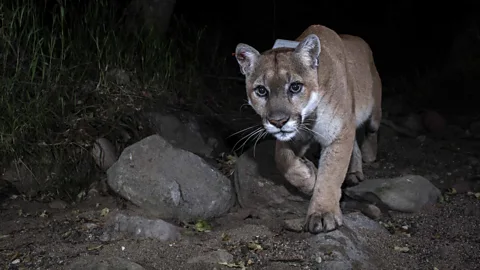 Miguel Ordeñana
Miguel OrdeñanaThe Wallis Annenberg Wildlife Crossing won't officially open until late 2026, but it has already spurred momentum in the wildlife crossing space, according to Pratt and Rock. Pratt has launched the Wildlife Crossing Fund, with help from Annenberg, where she consults with outside groups how to create similar campaigns for wildlife corridors in places like Washington, Colorado and Florida.
Rock is now working on drafting plans for everything from a salamander crossing down in Jackson, Mississippi, to a crossing for bighorn sheep on the nation's first tribal national park in North Dakota.
In 2021, the US Congress provided funding for a wildlife crossing pilot programme administered by the Federal Highway Administration to reduce wildlife vehicle collisions. While the bill passed by former President Joe Biden is facing defunding under the current administration, ecologists like Cramer hope the programme will become permanent.
In Southern California, wildlife crossings are already growing in popularity. There's also a study underway for a bridge across Los Angeles’s Interstate 5 and 100 miles (161km) north of Los Angeles another crossing was recently funded to cross the 101 Freeway along the Gaviota coastline.
In December 2022, P-22 started exhibiting erratic behaviour. At 12-years-old, the mountain lion began coming closer to houses and humans and attacked and killed a small dog as he was being walked on a leash. When park officials captured him, they found P-22 was suffering from rodenticide and looked like he'd been hit by a car.
The day before they put him down, Pratt said she finally got to meet P-22 face to face, the mountain lion she'd made a central part of her life for the past decade. Separated by a fence, she said she talked to him about the movement he had helped inspire.
"I told him he was a good boy and to look at what we were doing. And not only did this one crossing get built, but all were going to get built because of him," Pratt says.
"It's probably the first time in history that a mountain lion saw a blonde woman sobbing to him out of control."
--
For essential climate news and hopeful developments to your inbox, sign up to the Future Earth newsletter, while The Essential List delivers a handpicked selection of features and insights twice a week.
